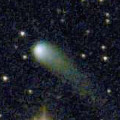
|
Now it is 10.0 mag (Nov. 28, Michael Jager). It is expected to brighten up to 8 mag in 2020. It stays observable in good condition for a long time in the Northern Hemisphere. In the Southern Hemisphere, it will be unobservable soon. Then it is not observable until July.
Date(TT) R.A. (2000) Decl. Delta r Elong. m1 Best Time(A, h)
Nov. 30 4 58.50 45 56.2 1.660 2.585 154 10.0 0:27 (180, 79)
Dec. 7 4 41.76 48 32.2 1.598 2.520 153 9.8 23:37 (180, 76)
|

|
Now it is 11.2 mag (Nov. 18, Juan Jose Gonzalez). It stays bright as 11 mag until winter. It stays observable in good condition for a long time in the Northern Hemisphere. In the Southern Hemisphere, it will be unobservable soon. Then it will never be observable again.
Date(TT) R.A. (2000) Decl. Delta r Elong. m1 Best Time(A, h)
Nov. 30 23 50.13 39 9.6 2.515 3.130 120 11.5 19:14 (180, 86)
Dec. 7 23 42.41 39 11.2 2.609 3.135 113 11.6 18:39 (180, 86)
|
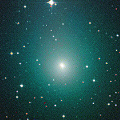
|
It brightened up to 8.3 mag in September (Sept. 20, Maik Meyer). Now it is fading. It has already faded down to 13.1 mag (Nov. 19, Chris Wyatt). In the Southern Hemisphere, it stays observable for a long time after this. In the Northern Hemisphere, it will be unobservable in early December.
Date(TT) R.A. (2000) Decl. Delta r Elong. m1 Best Time(A, h)
Nov. 30 21 37.03 -44 7.1 2.021 1.877 67 12.9 18:18 ( 14, 9)
Dec. 7 21 40.65 -44 44.2 2.195 1.938 61 13.3 18:18 ( 18, 7)
|

|
Now it is 14.7 mag (Nov. 19, Chris Wyatt).
Date(TT) R.A. (2000) Decl. Delta r Elong. m1 Best Time(A, h)
Nov. 30 0 25.16 13 13.3 5.180 5.780 123 13.3 19:50 ( 0, 68)
Dec. 7 0 24.98 13 2.8 5.278 5.781 116 13.3 19:22 ( 0, 68)
|
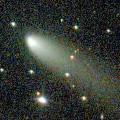
|
Now it is 12.4 mag (Nov. 16, Thomas Lehmann). It will fade out rapidly after this. It is observable in excellent condition in the Northern Hemisphere. It stays locating extremely low in the Southern Hemisphere.
Date(TT) R.A. (2000) Decl. Delta r Elong. m1 Best Time(A, h)
Nov. 30 2 23.56 48 42.8 0.771 1.673 144 13.5 21:48 (180, 76)
Dec. 7 2 25.21 47 40.5 0.829 1.713 141 13.9 21:22 (180, 77)
|
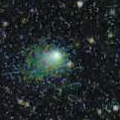
|
Now it is 13.6 mag (Nov. 15, Thomas Lehmann). It will be fading slowly after this.
Date(TT) R.A. (2000) Decl. Delta r Elong. m1 Best Time(A, h)
Nov. 30 20 47.62 -15 4.0 2.025 1.807 63 14.2 18:18 ( 36, 32)
Dec. 7 21 6.33 -14 26.3 2.087 1.817 60 14.3 18:18 ( 39, 31)
|
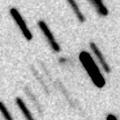
|
Now it is 15.3 mag (Nov. 5, Katsumi Yoshimoto). It brightens up to 14 mag in winter. It is observable in excellent condition in the Northern Hemisphere. It locates low in the Southern Hemisphere.
Date(TT) R.A. (2000) Decl. Delta r Elong. m1 Best Time(A, h)
Nov. 30 2 12.77 38 34.5 0.724 1.644 147 14.6 21:37 (180, 87)
Dec. 7 2 15.98 35 45.9 0.724 1.626 143 14.5 21:13 (180, 89)
|

|
Now it is 14.7 mag (Nov. 19, Chris Wyatt). It will be fading slowly after this. In the Southern Hemisphere, it becomes low from February to March, but it stays observable for a long time. In the Northern Hemisphere, it is not observasble until summer in 2020.
Date(TT) R.A. (2000) Decl. Delta r Elong. m1 Best Time(A, h)
Nov. 30 21 11.90 -71 43.5 3.562 3.255 64 14.6 18:18 ( 8,-18)
Dec. 7 21 26.51 -68 50.4 3.634 3.279 61 14.7 18:18 ( 10,-16)
|
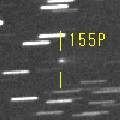
|
Now it is 15.4 mag (Nov. 1, Toshihiko Ikemura, Hirohisa Sato). It is observable at 14.5 mag in good condition in winter. It locates somewhat low in the Southern Hemisphere.
Date(TT) R.A. (2000) Decl. Delta r Elong. m1 Best Time(A, h)
Nov. 30 10 23.16 13 23.9 1.441 1.809 94 14.8 5:18 (340, 67)
Dec. 7 10 36.30 12 47.9 1.390 1.818 98 14.7 5:24 (353, 68)
|
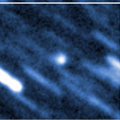
|
Now it is 14.8 mag (Oct. 30, Toshihiko Ikemura, Hirohisa Sato). It stays at 14.5-15 mag until December. It is observable in good condition in the Southern Hemisphere. It locates somewhat low in the Northern Hemisphere.
Date(TT) R.A. (2000) Decl. Delta r Elong. m1 Best Time(A, h)
Nov. 30 21 2.17 -13 55.6 1.930 1.787 66 14.7 18:18 ( 33, 35)
Dec. 7 21 17.81 -11 57.6 1.987 1.788 63 14.8 18:18 ( 37, 35)
|

|
It brightened up to 7.7 mag in June in 2018 (June 19, Juan Jose Gonzalez). Now it is fading. It has already faded down to 15.1 mag (Nov. 6, Toshihiko Ikemura, Hirohisa Sato). In the Southern Hemisphere, it stays observable for a long time until the comet will fade out. In the Northern Hemisphere, it stays low for a while.
Date(TT) R.A. (2000) Decl. Delta r Elong. m1 Best Time(A, h)
Nov. 30 6 33.69 -34 35.6 4.864 5.366 115 14.9 2:01 ( 0, 20)
Dec. 7 6 27.05 -34 26.7 4.880 5.423 118 15.0 1:27 ( 0, 21)
|

|
Now it is 16.3 mag (Nov. 2, Toshihiko Ikemura, Hirohisa Sato). It is fainter than this ephemeris recently.
Date(TT) R.A. (2000) Decl. Delta r Elong. m1 Best Time(A, h)
Nov. 30 9 37.29 6 29.5 2.344 2.735 102 15.0 5:04 ( 0, 61)
Dec. 7 9 39.27 6 2.3 2.284 2.767 109 15.1 4:39 ( 0, 61)
|
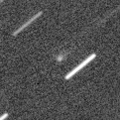
|
Now it is 15.6 mag (Nov. 6, Toshihiko Ikemura, Hirohisa Sato). The orbit is extremely hyperbolic with e=3.35. It is the first interstellar comet in history. It brightens up to 15 mag in December. In the Northern Hemisphere, it stays observable in good condition until early December. Then it will be getting lower, and it will be unobservable in mid January. In the Southern Hemisphere, it will be getting higher gradually. Then it will be observable in excellent condition.
Date(TT) R.A. (2000) Decl. Delta r Elong. m1 Best Time(A, h)
Nov. 30 11 13.90 -11 48.7 2.057 2.016 73 15.1 5:18 (334, 39)
Dec. 7 11 25.74 -17 7.7 2.004 2.007 75 15.0 5:24 (342, 36)
|

|
In the Southern Hemisphere, it is observable at 14.5 mag from winter to spring. In the Northern Hemisphere, it is not observable until August when it fades down to 17 mag.
Date(TT) R.A. (2000) Decl. Delta r Elong. m1 Best Time(A, h)
Nov. 30 16 13.48 -57 56.8 2.919 2.205 36 15.3 5:18 (322,-32)
Dec. 7 16 29.53 -60 16.4 2.863 2.172 37 15.2 5:24 (325,-30)
|
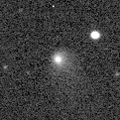
|
Now it is 14.7 mag (Nov. 19, Chris Wyatt). In the Southern Hemisphere, it is observable for a long time. It stays low in the Northern Hemisphere.
Date(TT) R.A. (2000) Decl. Delta r Elong. m1 Best Time(A, h)
Nov. 30 22 52.78 -31 12.0 4.665 4.688 85 15.3 18:18 ( 0, 24)
Dec. 7 22 54.35 -29 46.5 4.798 4.720 79 15.4 18:18 ( 6, 25)
|
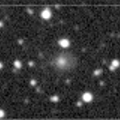
|
Now it is 15.0 mag (July 21, Taras Prystavski). It stays 16 mag for a long time from 2019 to 2020. It stays observable for a long time in the Southern Hemisphere. It is hardly observable in the Northern Hemisphere.
Date(TT) R.A. (2000) Decl. Delta r Elong. m1 Best Time(A, h)
Nov. 30 13 58.50 -81 37.8 3.795 3.440 61 15.8 5:18 (351,-31)
Dec. 7 14 54.72 -84 5.2 3.784 3.440 62 15.8 5:24 (354,-33)
|
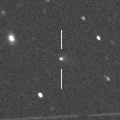
|
Now it is 14.8 mag (Nov. 4, Sandor Szabo). It stays 15-16 mag until December, and it is observable in good condition.
Date(TT) R.A. (2000) Decl. Delta r Elong. m1 Best Time(A, h)
Nov. 30 23 54.15 -7 34.1 1.873 2.375 108 15.9 19:19 ( 0, 48)
Dec. 7 23 59.83 -6 42.5 1.942 2.366 102 15.9 18:57 ( 0, 48)
|

|
Now it is 14.8 mag (Aug. 28, Chris Wyatt). It will be fading slowly after this. In the Southern Hemisphere, it stays observable in good condition for a long time, although it becomes low from October to November. It will never be observable after this in the Northern Hemisphere.
Date(TT) R.A. (2000) Decl. Delta r Elong. m1 Best Time(A, h)
Nov. 30 14 20.89 -55 5.6 5.080 4.377 40 15.9 5:18 (327,-17)
Dec. 7 14 24.41 -56 28.7 5.083 4.418 43 16.0 5:24 (330,-15)
|

|
Now it is 17.4 mag (Nov. 3, Toshihiko Ikemura, Hirohisa Sato). It will brighten up to 13.5-14 mag from 2020 to 2021. It stays observable in good condition for a long time after this until 2020 summer.
Date(TT) R.A. (2000) Decl. Delta r Elong. m1 Best Time(A, h)
Nov. 30 12 33.04 12 31.3 3.930 3.635 65 16.3 5:18 (292, 47)
Dec. 7 12 39.84 12 10.8 3.820 3.617 70 16.2 5:24 (298, 52)
|

|
Now it is 16.7 mag (Nov. 14, Thomas Lehmann). It is expected to be observable at 5-6 mag for a long time from 2022 to 2023. In the Northern Hemisphere, it is not observable at the high light from 2022 summer to 2023 summer. In the Southern Hemisphere, it stays unobservable for a while. But it will be observable in good condition at the high light.
Date(TT) R.A. (2000) Decl. Delta r Elong. m1 Best Time(A, h)
Nov. 30 17 32.17 46 10.6 10.645 10.342 69 16.3 18:18 (127, 31)
Dec. 7 17 35.88 45 53.4 10.603 10.293 69 16.3 18:18 (129, 27)
|

|
Now it is 16.7 mag (Nov. 1, Ken-ichi Kadota). It will brighten up to 10.5 mag from 2020 December to 2021 January. In the Northern Hemisphere, it stays observable in good condition while the comet will be brightening gradually, but it is not observable at the high light. In the Southern Hemisphere, it is not observable for a long time, but it will be observable in good condition after the high light.
Date(TT) R.A. (2000) Decl. Delta r Elong. m1 Best Time(A, h)
Nov. 30 17 12.05 62 9.2 4.540 4.549 84 16.4 18:18 (146, 33)
Dec. 7 17 19.94 61 29.6 4.477 4.486 84 16.3 18:18 (146, 30)
|

|
Now it is 15.3 mag (Nov. 4, Sandor Szabo). It will be fading after this, and it will be fainter than 18 mag in January.
Date(TT) R.A. (2000) Decl. Delta r Elong. m1 Best Time(A, h)
Nov. 30 2 1.05 -3 14.9 1.825 2.639 137 16.5 21:24 ( 0, 52)
Dec. 7 1 42.14 -4 59.3 1.967 2.669 126 16.7 20:38 ( 0, 50)
|

|
It has not been observed yet in this apparition. Now it is fainter than 21.5 mag (Aug. 4, Erwin Schwab). It was expected to brighten up to 12 mag from August to September. But actually, it must be much fainter than expected. It is observable in good condition in the Northern Hemisphere. It is not observable in the Southern Hemisphere.
Date(TT) R.A. (2000) Decl. Delta r Elong. m1 Best Time(A, h)
Nov. 30 7 28.39 61 40.6 1.089 1.871 128 16.8 2:57 (180, 63)
Dec. 7 7 17.02 62 23.9 1.106 1.920 133 17.4 2:18 (180, 63)
|

|
It stays 16-17 mag for a long time until 2020. It is observable in good condition in the Northern Hemisphere. It is hardly observable in the Southern Hemisphere.
Date(TT) R.A. (2000) Decl. Delta r Elong. m1 Best Time(A, h)
Nov. 30 13 12.56 51 43.3 8.648 8.602 84 16.9 5:18 (229, 51)
Dec. 7 13 16.55 51 49.5 8.589 8.610 87 16.8 5:24 (228, 55)
|

|
Fading. Now it is 17.3 mag (Nov. 1, Toshihiko Ikemura, Hirohisa Sato). It stays 17 mag from autumn to winter. It is observable in good condition in the Northern Hemisphere. It locates low in the Southern Hemisphere.
Date(TT) R.A. (2000) Decl. Delta r Elong. m1 Best Time(A, h)
Nov. 30 9 9.11 23 39.8 6.108 6.576 114 16.9 4:36 ( 0, 79)
Dec. 7 9 5.02 23 41.1 6.041 6.619 122 16.9 4:05 ( 0, 79)
|

|
Now it is 17.1 mag (Oct. 31, Toshihiko Ikemura, Hirohisa Sato). It will be fading after this, and it will be fainter than 18 mag in late December.
Date(TT) R.A. (2000) Decl. Delta r Elong. m1 Best Time(A, h)
Nov. 30 3 12.50 26 20.0 1.407 2.369 163 17.2 22:36 ( 0, 81)
Dec. 7 3 8.36 25 36.9 1.461 2.395 156 17.4 22:05 ( 0, 81)
|
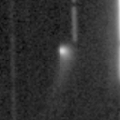
|
Now it is 17.7 mag (Oct. 31, Toshihiko Ikemura, Hirohisa Sato). It will be fading after this. In the Northern Hemisphere, it stays observable in good condition for a long time. In the Southern Hemisphere, it stays extremely low for a long time.
Date(TT) R.A. (2000) Decl. Delta r Elong. m1 Best Time(A, h)
Nov. 30 1 19.26 35 33.7 3.629 4.411 137 17.2 20:43 (180, 89)
Dec. 7 1 12.05 33 31.9 3.745 4.452 130 17.4 20:08 ( 0, 89)
|

|
Now it is 16.4 mag (Oct. 30, Toshihiko Ikemura, Hirohisa Sato). It stays observable in good condition while the comet will be fading slowly after this.
Date(TT) R.A. (2000) Decl. Delta r Elong. m1 Best Time(A, h)
Nov. 30 3 12.29 -2 3.1 1.854 2.758 150 17.3 22:36 ( 0, 53)
Dec. 7 3 10.15 -2 0.7 1.945 2.810 145 17.5 22:06 ( 0, 53)
|
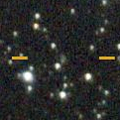
|
Now it is 17.3 mag (Oct. 26, Toshihiko Ikemura, Hirohisa Sato). It will brighten up to 12 mag in winter in 2022.
Date(TT) R.A. (2000) Decl. Delta r Elong. m1 Best Time(A, h)
Nov. 30 22 3.83 42 29.0 7.095 7.351 101 17.4 18:18 (132, 78)
Dec. 7 22 5.80 42 0.3 7.123 7.306 96 17.4 18:18 (121, 74)
|

|
Fading now. Now it is 17.1 mag (Oct. 5, M. Masek). In the Southern Hemisphere, it stays observable for a long time until it fades out. In the Northern Hemisphere, it will not be observable after this.
Date(TT) R.A. (2000) Decl. Delta r Elong. m1 Best Time(A, h)
Nov. 30 5 47.02 -54 35.5 5.212 5.498 101 17.4 1:14 ( 0, 0)
Dec. 7 5 35.62 -55 16.5 5.266 5.550 101 17.5 0:36 ( 0, 0)
|
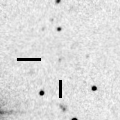
|
Now it is 17.4 mag (Oct. 31, Ken-ichi Kadota). It is observable at 17-18 mag for a long time from late 2019 to early 2021. It will fade out before it passes the perihelion.
Date(TT) R.A. (2000) Decl. Delta r Elong. m1 Best Time(A, h)
Nov. 30 3 3.36 0 35.4 4.257 5.147 151 17.5 22:27 ( 0, 56)
Dec. 7 3 0.14 0 40.3 4.294 5.133 145 17.5 21:56 ( 0, 56)
|
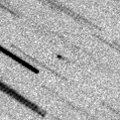
|
First return of a new periodic comet which brightened up to 18 mag in 2014. Now it is 17.2 mag (Nov. 1, Toshihiko Ikemura, Hirohisa Sato). It will be fainter than 18 mag in December. It is observable in good condition in the Northern Hemisphere. It locates extremely low in the Southern Hemisphere.
Date(TT) R.A. (2000) Decl. Delta r Elong. m1 Best Time(A, h)
Nov. 30 8 11.35 44 0.3 0.407 1.277 127 17.6 3:39 (180, 81)
Dec. 7 8 6.87 43 56.8 0.426 1.320 134 17.8 3:07 (180, 81)
|
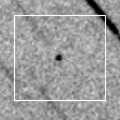
|
Fading now. It passed the perihelion on July 2. Then it must have brightened up to 13 mag, but it was not observable around that time. In the Northern Hemisphere, it stays observable in excellent condition until December when it becomes fainter than 18 mag. In the Southern Hemisphere, it stays locating low.
Date(TT) R.A. (2000) Decl. Delta r Elong. m1 Best Time(A, h)
Nov. 30 0 17.59 30 5.4 1.379 2.106 125 17.7 19:42 ( 0, 85)
Dec. 7 0 16.73 27 49.5 1.493 2.143 118 17.9 19:14 ( 0, 83)
|
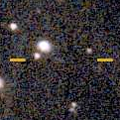
|
Now it is 17.9 mag (Oct. 29, Toshihiko Ikemura, Hirohisa Sato). It is observable at 18 mag in good condition in winter. It locates somewhat low in the Southern Hemisphere.
Date(TT) R.A. (2000) Decl. Delta r Elong. m1 Best Time(A, h)
Nov. 30 4 14.77 24 15.0 2.256 3.241 176 17.8 23:38 ( 0, 79)
Dec. 7 4 9.87 23 57.6 2.260 3.235 170 17.8 23:06 ( 0, 79)
|

|
Now it is 17.8 mag (Nov. 2, Toshihiko Ikemura, Hirohisa Sato). It was exptected to brighten up to 16.5 mag from October to December. But actually, it is fainter than originally expected. It seems to brighten up to 18 mag at best. It is observable in good condition in the Northern Hemisphere. It locates low in the Southern Hemisphere.
Date(TT) R.A. (2000) Decl. Delta r Elong. m1 Best Time(A, h)
Nov. 30 9 41.62 31 26.1 1.027 1.642 109 17.8 5:08 ( 0, 86)
Dec. 7 9 56.56 34 30.2 0.997 1.658 113 17.8 4:56 ( 0, 89)
|
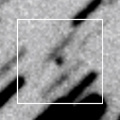
|
Asteroid moving along a comet-like orbit. It stays observable at 17.5 mag from 2020 to 2021. It locates somewhat low in the Northern Hemisphere.
Date(TT) R.A. (2000) Decl. Delta r Elong. m1 Best Time(A, h)
Nov. 30 10 51.98 -22 41.2 6.847 6.664 75 17.9 5:18 (344, 30)
Dec. 7 10 54.44 -23 11.1 6.743 6.657 80 17.8 5:24 (352, 31)
|

|
It brighted rapidly from 20.5 mag up to 18.5 mag in September. However, the brightness evolution has stopped since October. Now it is very faint as 18.9 mag (Nov. 21, Katsumi Yoshimoto). It will approaches to Earth down to 0.09 a.u. in early January, and it will brighten up to 15.5 mag. It will be obesrvable in excellent condition in the Northern Hemisphere. In the Southern Hemisphere, it will not be observable at the high light.
Date(TT) R.A. (2000) Decl. Delta r Elong. m1 Best Time(A, h)
Nov. 30 22 29.62 -16 25.6 0.280 1.006 85 18.5 18:18 ( 7, 39)
Dec. 7 22 36.42 -12 43.8 0.245 0.980 81 18.3 18:18 ( 14, 41)
|
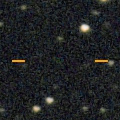
|
Now it is very faint as 19.7 mag (Oct. 25, Toshihiko Ikemura, Hirohisa Sato). It brightened up to 15.5 mag in 1997, and 17 mag in 2008, however, it is much fainter in this apparition.
Date(TT) R.A. (2000) Decl. Delta r Elong. m1 Best Time(A, h)
Nov. 30 1 5.09 13 23.4 2.618 3.366 132 20.4 20:29 ( 0, 68)
Dec. 7 1 5.61 12 55.0 2.704 3.373 125 20.4 20:02 ( 0, 68)
|
|
![]()
 C/2010 U3 ( Boattini )
C/2010 U3 ( Boattini ) C/2015 O1 ( PanSTARRS )
C/2015 O1 ( PanSTARRS ) 261P/Larson
261P/Larson C/2018 A3 ( ATLAS )
C/2018 A3 ( ATLAS ) C/2019 K5 ( Young )
C/2019 K5 ( Young ) C/2019 L3 ( ATLAS )
C/2019 L3 ( ATLAS ) C/2016 N6 ( PanSTARRS )
C/2016 N6 ( PanSTARRS ) 173P/Mueller 5
173P/Mueller 5 384P/2019 O1 ( Kowalski )
384P/2019 O1 ( Kowalski ) (3200) Phaethon
(3200) Phaethon 203P/Korlevic
203P/Korlevic 76P/West-Kohoutek-Ikemura
76P/West-Kohoutek-Ikemura A/2019 C1
A/2019 C1 289P/Blanpain
289P/Blanpain 200P/Larsen
200P/Larsen![]()



































